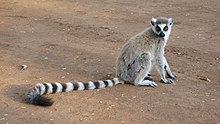Ring-tailed lemur
large species of strepsirrhine primate
The ring-tailed lemur (Lemur catta) is a primate from the group of lemurs (Lemuriformes). It lives in the dry regions of southwest Madagascar.
| Ring tailed lemur | |
|---|---|
 | |
| Scientific classification | |
| Domain: | Eukaryota |
| Kingdom: | Animalia |
| Phylum: | Chordata |
| Class: | Mammalia |
| Order: | Primates |
| Suborder: | Strepsirrhini |
| Family: | Lemuridae |
| Genus: | Lemur Linnaeus, 1758 |
| Species: | L. catta |
| Binomial name | |
| Lemur catta | |
 | |
| Distribution of Lemur catta | |
| Synonyms | |
Genus:[1]
Species:[1]
| |
This lemur weighs between 2 to 3.5 kilograms (4.4 to 7.7 lb). It can live up to 20 years. [2] It is a mid-sized lemur. The striped tail makes it easy to recognize. Its behaviour is somewhat unusual for lemurs: it is active during the day, and spends much time on the ground. Ring-tailed lemurs live in groups of 12 to 15 animals. Each group is led by a female. Ring-tailed lemurs eat both meat and plants, but they mainly eat fruit. They live only in Madagascar. The main threats to ring-tailed lemurs are destroying the places where it lives and hunting.
References
Notes
🔥 Top keywords: Main PageSpecial:Search0Slash (punctuation)BlackSpecial:RecentChanges4 (number)DavidSOLID (object-oriented design)Wikipedia:AboutFile:Sexual intercourse with internal ejaculation.webmHelp:ContentsHelp:IntroductionLisa Sparxxx2023 UEFA Champions League FinalColour24-hour clockAdolf Hitler UunonaBismillahir Rahmanir Raheem6 (number)T. N. SeshanFile:ASCII-Table-wide.svg20 (number)Poor Things (movie)United StatesCristiano RonaldoList of people who have walked on the MoonAli Malikov50 (number)17 (number)The Valley (2024 TV series)GrassList of mathematical symbolsList of U.S. states and territories by time zone8 (number)List of countries by areaWikipedia:Simple talkList of largest Hindu templesRama

